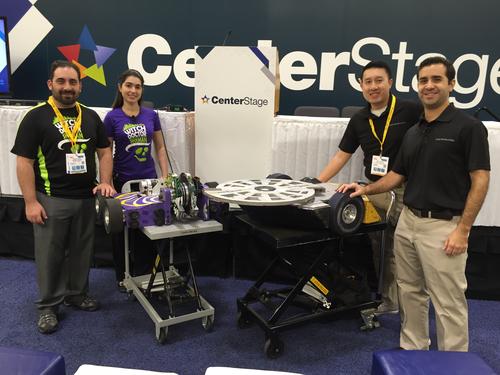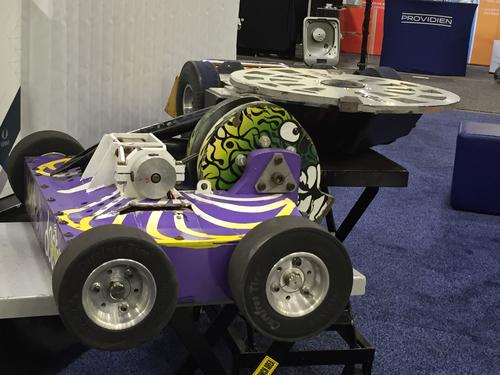BattleBots & Their Designers Show Off Moves & Design Tips
BattleBot engineers from the hit TV show showed off two teams' robot designs at a session held yesterday at the Design & Manufacturing Minneapolis show.
September 22, 2016
BattleBot engineers from the hit TV show showed off two teams' robot designs at a session held yesterday at the Design & Manufacturing Minneapolis show and co-located events.

Shown here with members of their respective teams, Andrea Suarez (second from left) and Victor Soto (far right) presented their BattleBot designs and gave tips about designing rugged robots and medical devices, which have some challenges in common.
Andrea Suarez and Victor Soto are medical device engineers by day, and BattleBot robot builders by night. Friends since high school, in their day jobs they figure out how to apply engineering principles to medical device design: Suarez is senior engineer II at Zimmer Biomet, and Soto is senior staff systems engineer at Stryker. Yet many of the challenges they encounter are similar to those needed for improving the designs of robots that can destroy each other in the BattleBox.
In its seventh season this year, the TV show is featuring 60 different BattleBot designs. Since none of the teams know what the others are designing before they meet in competition, the task is to "design a robot to fight a lot of other robots that you don't see until the show itself," said Suarez. Her team's robot is Witch Doctor, a 250-lb multi-bot with a skull-shaped dual-disk S7 steel weapon that spins vertically at over 4,000 rpm. A smaller, 30-lb partner bot called Shaman uses flamethrowers to send out eight feet of green flame against an enemy.

The Witch Doctor BattleBot is a 250-lb multi-bot with a skull-shaped dual-disk S7 steel weapon that spins vertically at over 4,000 rpm.
Witch Doctor's current design includes adjustments made from the previous season, said Suarez. These were primarily a boost in robustness, making it better able to withstand huge hits, and isolating components such as the center rail from load paths. The team also carefully chose the location of critical components, and added a self-righting mechanism after the bot lost a battle when it got turned over. Witch Doctor has AR400 defensive armor, a 1.5-inch 2024 aluminum frame, four-wheel drive, and shock-absorbing solid foam tires.
READ MORE ARTICLES ON ROBOTICS:
Soto's team has built Rotator, also 250 lbs, but with a very different design. This bot has a 3/4-inch aluminum structure, and 20 mph two-wheel drive. Each of its two horizontal blades runs at 300 mph, weighs 30 lb, and has hardened steel-cutting teeth. This bot was designed for robustness, as well as built to be easy to assemble and disassemble, said Soto, and to keep costs low local vendors were used and parts were 3D printed whenever possible.

Each of Rotator's two horizontal blades runs at 300 mph, weighs 30 lb, and has hardened steel-cutting teeth.
Rotator's twin blades are independent weapon systems: each has separate speed control and separate battery packs. They are so large relative to the body size that their span covers most of the robot. The areas that are likely to get hit are covered in thick, 3/8-inch titanium armor. Each wheel has a powerful drive system, since failure is guaranteed if drive is lost, and in case of a double weapon failure, the robot must be able to drive and push. Other design features include aligning the robot's center of gravity with the wheel axis for optimum traction and control, and shock mounting the electronics to dissipate energy from large hits.
Both bots have only joined in battle together once, and they were evenly matched, said Suarez. Will they again? The BattleBot engineers aren't telling.
[images via Naomi Price/Design News]
Ann R. Thryft is senior technical editor, materials & assembly, for Design News. She's been writing about manufacturing- and electronics-related technologies for 29 years, covering manufacturing materials & processes, alternative energy, and robotics. In the past, she's also written about machine vision and all kinds of communications.
About the Author(s)
You May Also Like



